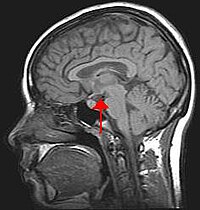
Photo from wikipedia
Obesity has become a global epidemic, and it is a major risk factor for other metabolic disorders such as type 2 diabetes and cardiometabolic disease. Accumulating evidence indicates that there… Click to show full abstract
Obesity has become a global epidemic, and it is a major risk factor for other metabolic disorders such as type 2 diabetes and cardiometabolic disease. Accumulating evidence indicates that there is sex-specific metabolic protection and disease susceptibility. For instance, in both clinical and experimental studies, males are more likely to develop obesity, insulin resistance, and diabetes. In line with this, males tend to have more visceral white adipose tissue (WAT) and less brown adipose tissue (BAT) thermogenic activity, both leading to an increased incidence of metabolic disorders. This female-specific fat distribution is partially mediated by sex hormone estrogens. Specifically, hypothalamic estrogen signaling plays a vital role in regulating WAT distribution, WAT beiging, and BAT thermogenesis. These regulatory effects on adipose tissue metabolism are primarily mediated by the activation of estrogen receptor alpha (ERα) in neurons, which interacts with hormones and adipokines such as leptin, ghrelin, and insulin. This review discusses the contribution of adipose tissue dysfunction to obesity and the role of hypothalamic estrogen signaling in preventing metabolic diseases with a particular focus on the VMH, the central regulator of energy expenditure and glucose homeostasis.
Journal Title: Frontiers in Endocrinology
Year Published: 2022
Link to full text (if available)
Share on Social Media: Sign Up to like & get
recommendations!